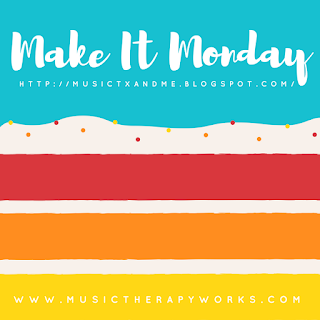Make It Monday: The 7 Visual Aids Every School-Based Therapist Should Have Handy...
It is Monday morning, I have two weeks of my vacation from my school therapy job in front of me, Mom is coming tomorrow and my living space is not at all ready for her (but it is much, MUCH better than it was), I've sprained my knee, and I'm trying to figure out what to write about today.
Oh, I know - visual aids - my other interest at the moment! I promise I'll only mention my TPT store this once - I'll be putting up a visual aid kit later this week that contains all of the non-free resources that I recommend below, and that's the last mention!
Now, some of these visuals are easily made - get a camera, a printer, and some cardstock and off you go! Others are not as easily found, but I have some resources for you listed below of (free or almost free) resources to make and use during your music therapy sessions. Are you ready to see my list? Here we go!
Happy Monday!
Oh, I know - visual aids - my other interest at the moment! I promise I'll only mention my TPT store this once - I'll be putting up a visual aid kit later this week that contains all of the non-free resources that I recommend below, and that's the last mention!
Now, some of these visuals are easily made - get a camera, a printer, and some cardstock and off you go! Others are not as easily found, but I have some resources for you listed below of (free or almost free) resources to make and use during your music therapy sessions. Are you ready to see my list? Here we go!
- Alphabet cards - this one seems pretty simple when you think of it, but having a set of alphabet cards offers lots of options to students and to therapists. Alphabet cards allow for letter identification therapeutic music experiences (TMEs) - I use them to indicate steps in a process, to set up obstacle courses and/or gross motor exercises. I also use them in sound recognition TMEs and in many different games. Here's a link to a list of alphabet cards available to you for free!
- Alphabet Board - this one is often less accessible, but with the rise of electronic devices to assist with non-verbal communication, having an alphabet board can go a long way towards getting answers from a client. In order to spell words, the client points to the letters, spelling out the word in its entirety. Here's a link to a great one coming to us from Australia!
- Number cards - same as the letter cards above, number cards are indispensable in my music therapy clinic. We use them to choose the number of repetitions for a favorite song, we compose with them, we exercise with them, we indicate times and dates with them, and they are often the cards we draw when we are playing games. There are lots of free resources for this type of visual - here's just one link from Teachers Pay Teachers.
- Emotion cards - I have used emotion cards for my entire career, and I have many different types of emotion cards - hand-drawn, Google image cards, teacher resources, you name it! About a year ago, I wanted some multi-cultural PECS to use during my opening TMEs - something that represented the multi-cultural nature of my clients better than the resources I had available to me. I stumbled upon this site, Educate Autism. They had everything I wanted AND more! I've mixed the skin tones up between four binders to see if kids were more drawn to their own skin tones or others or whether they were actually looking at the emotions. After 18 months of using these, I can tell you that my clients don't really seem to care about the color of skin, they tend to find their favorite emotion regardless. I have had to remove some options because clients like acting out the emotions so much that there is real disparity between how they act and how they indicate they are feeling. One young man loves to watch others shiver, so he ALWAYS picks COLD (even when it is 80+ degrees in the music therapy room!).
- Color cards - These help my clients with indicating specific colors in many different situations and settings. We use them to work on receptive language, expressive language, and choices. There are way too many options out there to link to any one site - just type in "education color cards" to find the countless options that I found...
- Music notation cards - I use these so much it's ridiculous. I have a set of 48 notes, evenly split between whole, half, quarter, and eighth notes. We use them to play card games, to compose music, to work on symbol representations, music education concepts, and audio discrimination. This link has the types of cards that I use and so many more!
- Instrument option cards - This is another resource that I use often - pictures of the instruments that I have in my music therapy clinic. Unfortunately, there is no substitution for going into your instrument closet and taking pictures, so this is one that you'll have to make on your own. I use these cards to offer options to clients. I can put the exact number of cards to correspond to exact number of instruments that I have available to use. I can offer up every option or I can tuck some of the options away to limit what my clients are able to choose.
Happy Monday!


Comments
Post a Comment